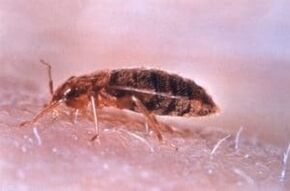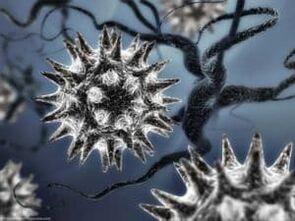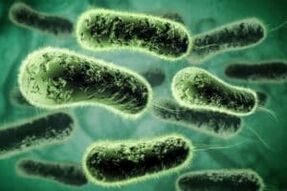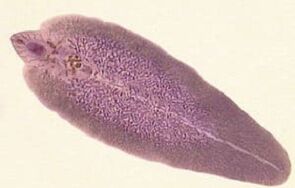By knowing the ways in which parasites enter the body, it is possible to take preventive measures in contact with possible sources of infection. What helminths are, like intestinal parasites, is known to many. However, the average person is less aware of the species that live in the circulatory system, subcutaneous lymph, muscles, brain and internal organs.
All types of parasites in the human body are divided into representatives: protozoa, flat and round worms, arthropods and their larvae.Viruses, pathogenic bacteria and fungi can be classified as parasites, but are divided into a separate group. Infectious diseases are divided into: viral, fungal, bacterial and parasitic. Included in the classification of human parasites - a unique species of fish (common vandellia) that can penetrate the human urinary tract (random host).
Parasitism and its types

Who are the parasites? These are organisms that live at the expense of another individual, are not genetically related to him, and enter into antagonistic relationships, that is, they interfere with life. The concept of parasitism should not be extrapolated to living microorganisms without damaging specific organs living inside the body. In nature, there are plant and animal parasites, depending on the type of host. During the operation of this lifestyle, the parasite and the host system work continuously. The task of the first: to live the second, to live without killing him for a long time.
Classification of parasites by type:
- Locations: external and internal parasites (exo- and endoparasites).
- By lifestyle: parasitic (compulsory) and free forms of life that began to exist under certain conditions at the expense of another organism (optional parasites).
- By time of contact with the host: temporary and permanent parasites (stationary and periodic).
Animal parasites in the food chain are generally secondary or tertiary consumers because they feed on herbivores or carnivores. The parasite's feeding pattern deprives the host of nutrients and / or leads to the destruction of cells and tissues. Conflicts between homeowners often occur because dangerous residents release toxic metabolic products. It causes certain symptoms (allergies, digestive disorders, signs of damage to various internal organs).
Viruses

Viruses are intracellular parasites of protein-genetic structure. They reproduce themselves thanks to the materials of the cell. The virus is a mandatory parasite.
According to the classification, viruses containing RNA and DNA are isolated according to the type of genetic material. Intracellular agents of the first group include:
- Enteroviruses. They multiply in the digestive system and cause problems in various human organs.
- Rhinoviruses. The causative agents of ARVI.
- Influenza, rabies and tick-borne encephalitis viruses.
- Papillomaviruses.
The second group includes: adenoviruses (causes acute respiratory infections), herpes and smallpox pathogens.
Viruses that enter the target cell control their processes, integrate into genetic material or localize in the cytoplasm, and then multiply (multiply). Cell death then occurs as a result of lysis, apoptosis, or disruption of membrane structure. Some agents (papillomaviruses, Epstein-Barr virus) can cause cells to become malignant.
How viruses penetrate:
- Weather.
- From the gastrointestinal tract when drinking water and eating.
- through the outer mucous membranes, such as the skin and conjunctiva of the eye.
- Through arthropod vectors (insects, ticks).
- As a result of the use of non-sterile medical devices (syringes, pipettes).
Each virus adapts to a specific cell, differentiating its target with the help of receptors.
Bacteria

Rickettsiae and intracellular parasites have a special place among bacteria. These are the most primitive representatives resembling viruses. In humans, these microorganisms: typhoid, tick-borne rickettsiosis, Rocky Mountain spot fever. People get rickettsiae from tick bites, lice and lice.
Intracellular parasites of other chlamydia cause one of the most common venereal diseases (chlamydia) and cause severe eye inflammation, infantile pneumonia and enteritis.
Dangerous bacteria include:
- Salmonella is the causative agent of typhoid fever.
- Tetanus rod.
- A pale spirochete, which causes syphilis and delays treatment because the disease is difficult to diagnose.
- Pneumococci that can cause pneumonia and less common bacterial meningitis.
- Tuberculosis bacilli that do not manifest themselves for a long time and can then turn into an open form.
- Escherichia coli due to its ability to develop antibiotic resistance. Gastroenteritis rarely causes meningitis and urinary tract infections.
External parasites such as Staphylococcus aureus are known to cause a wide range of skin infections. The most dangerous consequences of its activity: pneumonia, meningitis, osteomyelitis, endocarditis, shock due to exposure to bacterial toxins and sepsis (in everyday life it is called blood poisoning).
Mushrooms

Disease-causing fungi - human parasites are better protected from bacteria than drugs. The most common fungal disease is candidiasis localized in various mucous membranes with a weakened immune system. Candida species live in the body of any healthy person and cause material damage only when the protective function is violated. Conventionally, pathogenic bacteria and fungi are a group of microorganisms that border non-pathogenic and pathogenic categories. Therefore, as a rule, they are not classified as parasites.
Pathogenic mycelial fungi are human parasites that often cause external surface diseases:
- Keratomycosis. Reproduction of fungi occurs in the keratinized zone of the epidermis or in the hair follicle (trichosporia nodosum, versicolor versicolor).
- Dermatophytosis. Pathogens affect not only the epidermis, but also the dermis, nails and hair (ringworm, scab).
- Deep mycoses. Damage to the skin and nearby tissues, as well as internal organs. These include histoplasmosis - a severe systemic fungal disease and aspergillosis - damage to the mucous membranes and skin caused by aspergillus.
The classic sources of bacterial and fungal infections are sick people, animals, soil, dirty water and food.
Protozoa
Protozoa is another single-celled parasite along with bacteria and fungi. Which protozoan parasites are isolated in a person depending on their systematic position?
- Some amoebae are optional parasites. The most popular is the dysentery amoeba, which enters the human body in the form of a cyst (a form of rest). The pathogen enters the large intestine (luminal form), then penetrates the mucous membrane and affects various internal organs through the bloodstream. Amoebae are aquatic organisms, so the main source of infection is dirty water. Acanthamoeba keratitis is a rare eye disease that is more common due to the increasing popularity of contact lenses.
- Flags (Leishmania, Giardia, Trichomonas). Trichomoniasis is the most common disease of the genitourinary system, dangerous for complications (infertility, prostatitis, premature birth, etc. ).
- Apicomplexes (Sporozoans). Except for colpodelids, the group includes only obligate parasites (Toxoplasma, Plasmodium malaria, Cryptosporidium, Coccidia, sarcocysts). Sporozoan cysts enter the body after being bitten by insects, eating infected animals, or drinking water.
- Eyelashes. Balantidia is dangerous for humans, causing diarrhea and ulcers in the intestinal wall as a result of activity in the large intestine. Ciliates are the largest pathogenic single-celled organisms.
The simplest human parasites cause protozoal infections (protozoa). What parasites live in the human nervous system among protozoa? For example, the causative agents of toxoplasmosis and cerebral malaria. Among the amoebae, the facultative parasite Neglerius Fowler is able to infect the nervous system.
Multicellular
Multicellular parasites include flatworms, roundworms, arachnids, and insects. First, as a rule, it inhabits the inside of a person (in various systems and internal organs) and some species migrate or penetrate (ringworm, Gnathostoma spinigerum larvae and hookworms, schistosomes) into the subcutaneous layer. Worms are the collective colloquial name of all worms that cause helminthic infestations (helminthiasis).
Common diseases caused by flatworms
Group of trematodes (digenetic flukes):
- Opisthorchiasis. Predators: types of liver flukes, for example, a mixture of cat and Siberian. Infection occurs as a result of eating thermally weakly processed, infected tea fish.
- Fascioliasis. Causes liver and giant flukes. Infection occurs through the consumption of contaminated water or shore grass.
- Schistosomiasis. The causative agents of schistosomes (especially blood test) live mainly in hot climates. They penetrate the skin by contact with water.
- Paragonimiasis. The cause of the disease is a lung fluke found in hot climates. Worm-infected and poorly processed thermal freshwater cancers or cancers are dangerous.

The life cycle of a parasite from the trematode group is complex, with several larval stages and gastropods as intermediate carriers. Flukes are animal parasites of vertebrates that act as temporary and permanent hosts. Individual larval stages can develop without fertilization. Flukes' devices for fixation and feeding inside the host are pacifiers.
Black worms are obligatory parasites of the human small intestine. Their bodies consist of segments (proglotids) that break down periodically and come out with the fertilized egg. The life cycle of earthworms necessarily includes a finna (blister worm) that occurs in a temporary host. The permanent host swallows the Finns, who develop a conical (mature) shape. The structural features of black worms are the lack of a digestive system and the absorption of food by the entire surface.
The most common:
- Beef tapeworm (unarmed tapeworm) causes teniarinhoses disease. The infection is caused by the meat of animals whose muscles are formed by the Finns, which are formed in the body after washing food with eggs.
- Pork worms (armed tapeworms) cause cysticercosis (Finn stage) and teniasis (adults). In addition to the absorbers, the helminth is equipped with an edge of the forks. A person can act as a medium and permanent owner at the same time.
- Wide tapeworm causes diphyllobotriasis. The average owners are copepods and fish. A person can be infected with insufficiently salted caviar and poorly cooked or fried freshwater fish.
Parasites feed on blood and tissue (flukes) or digested food (lenteworms).
Round Worms
What are the common types of worms (nematodes) that spread in humans?

- Ascaris. Ascariasis involves the migratory (larval) and intestinal (adult) stages. The larva penetrates the wall of the small intestine, bypasses the liver and heart, and travels to the lungs, bypassing the liver and heart. It enters the oral cavity, is reabsorbed and matures in the small intestine.
- Pinworm. The causative agent of enterobiasis feeds on the last and initial zones of the small and large intestines and multiplies in the intestine. Females lay eggs on anal wrinkles, which causes severe itching.
- Vlasoglav is the cause of trichocephalus. These parasites in the human body invade the mucous membrane of the beginning of the large intestine and feed on tissue fluid and blood.
- Trichinella causes dangerous trichinosis. In severe cases, the nervous system is damaged. These larvae are real killers that penetrate the wall of the small intestine and move around the body. They often enter the skeletal muscles, can penetrate the eyes, cause pain and swelling of the face, lungs, and cause coughing. So far no treatment has been invented for complete recovery.
- Toxocara. Distinguish larvae (more common) and imaginary (intestinal) toxocariasis. Occupation is characterized by the severity of allergic reactions. The larvae spread to all parts of the body and enter the tissues, forming and forming granulomas.
- Hookworm is more common in the tropics and subtropics. With ankylosing spondylitis, worms in the gut secrete proteolytic enzymes that destroy the walls and reduce blood clotting. Parasites in a human are caused by larvae entering the skin from contaminated water.
- Escherichia coli and related species are tropical parasites. The disease they cause, strongyloidiasis, can be asymptomatic for decades. With a decrease in immunity, the risk of death of worm carriers is high (60-85%).
- Rishta is a subtropical helminth that causes dracunculiasis. Larvae penetrate the intestinal wall. The female reaches the subcutaneous layer and expels the larvae from the skin when the host is in the water. The temporary host is a copepod crayfish.
The characteristics of the parasite's habitat affect the way it enters the body: contact with contaminated water or land, carriers of the larval stages that live there. Many representatives of roundworms do not have intermediate hosts and belong to geohelminths. Infection occurs mainly through contaminated water, unwashed hands, fruits or vegetables, as well as through the consumption of meat from wild animals.
Treatment of helminthiasis and terrible consequences
An important way to diagnose helminthiasis is a blood test. Along with other signs of infection, high concentrations of eosinophils (a type of white blood cell) indicate the presence of a worm and a number of pathogenic protozoa in the body. How are helminthiases treated? Medications are used to relieve symptoms and specific treatments. Antiallergic (desensitizing) and detoxification therapy is used. Most drugs are infused (drops are used), sometimes needles are used:
- A drug that replaces plasma and eliminates the effects of toxins.
- Isotonic glucose solution and saline.
- Vitamins C and B6.
- Sodium bicarbonate (soda), calcium chloride or gluconate.
- Preparations used at high temperatures.
- Hormonal drugs are used in difficult situations (with hepatitis or allergic myocarditis). Potassium intake is combined with them.
- Medications for heart failure and edema.
There is evidence that certain parasitic worms, such as pygmy tapeworms, can cause cancer. The stem cells of the larvae can turn into cancer. Parasites can indirectly cause cancer by weakening the immune system. Interesting data have been obtained in the study of the effects of trematodes on the liver. As a result of exposure to waste, normal cells can turn into cancer cells. Parasites are mainly localized in the digestive system, but larvae can penetrate various internal organs. For example, in the kidneys (echinococcosis, schistosomiasis), in the heart muscle (cysticercosis, hookworm disease), in the liver (echinococcosis). Parasitic worms in humans often affect the nervous system. Known cerebral cysticercosis, echinococcosis, alveococcosis and schistosomiasis.
Arthropods
Insects include popular ectoparasites such as fleas, bed bugs, and blood-sucking dipterans. Unlike lice, they are temporary parasites, that is, they live unstable with the help of the host. Arthropod parasites, which are arachnids, include the popular itch tick. Male and female mating occurs on the surface of the epithelium. Parasites in the human body then lay their eggs on the keratin layer of the skin, which causes severe itching. Most people know what ticks are. These are arthropod parasites of the arachnid family, including the most common representative of the tick mite - a carrier of dangerous infections (tick-borne encephalitis, Lyme disease). Blood-sucking dipterans include: non-malaria and malaria mosquitoes, mosquitoes, midges, biting midges, horse flies, and true flies. These arthropod parasites can cause severe allergic reactions and are also carriers of dangerous viral and bacterial infections. Some flies, especially rodents, cause larvae by placing larvae under human skin. Larvae can penetrate the body.






































